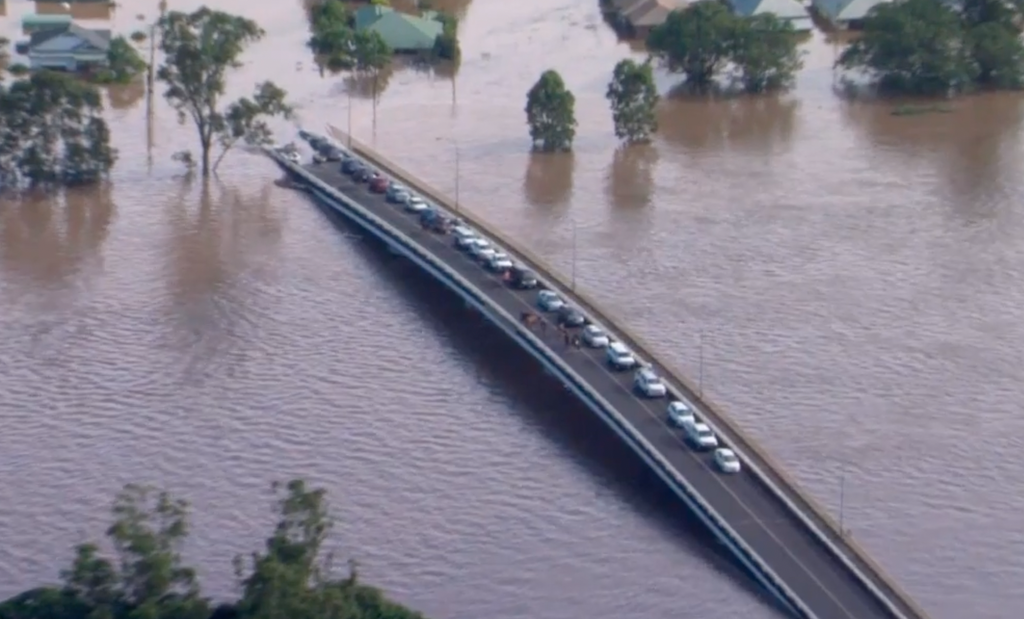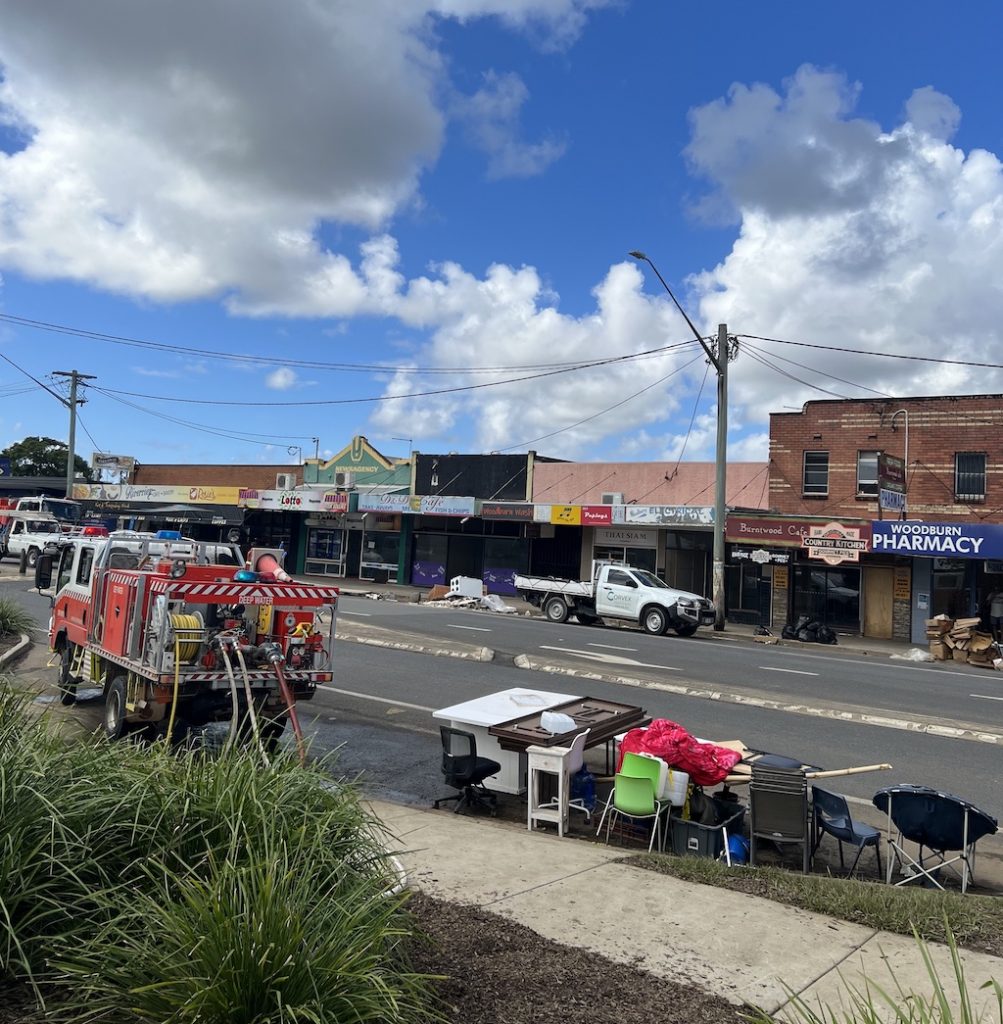What Northern Rivers Locals Want You To Understand About The Floods
"It's not okay at all. And it's not gonna be okay for a really long time."

There were many photos and videos that captured the horrors of the recent Northern Rivers floods, but one particular image stands out.
The night after the first flood at the end of February, helicopters caught sight of a cluster of locals seeking safety on Woodburn bridge. Surrounded by a sea of water, with both ends of the bridge submerged, residents had driven their cars, and belongings, and taken their horses up to the highest point of the bridge. They’d been there all night.

Residents and animals trapped on Woodburn bridge. Screenshot: Nine News
Just over a month later — and a little over a week after the second flood ripped through the region — a colleague and I stand at the bridge’s southern end. The water has receded, but the mud is everywhere. The local Rural Fire Service is hosing down the pavement and children’s playground, caked in a thick layer of dirt. Woodburn, a small town downriver from Lismore, was hit badly by the floodwaters — on the drive in we see cars floating in fields, the contents of houses strewn over paddocks.
Sam Daley, an occupational therapist from Yamba, who (along with a small army of locals from around the region, including my mum) has been spearheading the relief effort in Woodburn since the first flood — feeding families, sending supplies out to the smaller villages that are still cut off, sorting cleaning products and other items. One of the supplies they were scrambling to source in the days after the floods, she tells me, was snake kits. Snakes, fleeing the floodwaters like every other living thing, had infested the houses — locals would return to sort through muddy belongings only to find brown snakes leaping out at them from drawers. She tells us stories of people watching their beloved pets float downstream on mattresses, unable to be saved by the helicopters winching people to safety. Of people wandering, shell-shocked, into relief centres and just standing there, not knowing what to do.
For those who live outside of the region, who haven’t lived through it or seen it, these stories can seem too horrible to believe. And as the media attention dies down, as the federal election takes over the news cycle once again, the locals here feel angry and abandoned. The situation, Sam tells us, is still dire. And there are some things people need to understand.
“There’s No Just Going Back”
Kym Strow and her wife Sarah Jones run Flock Cafe in the middle of the Lismore CBD. It was inundated by water, and while the building is structurally sound they face an immense uphill battle to restore everything they lost. Their own house, which was supposedly above the flood level in another part of Lismore, has shifted on its foundations and the side is breaking off.
“Now it’s not in the news…people think it’s like a pot plant that some water got in and you just tip it out,” Kym tells me, sitting on the verandah of her temporary accommodation in Brunswick Heads. “There’s no just going back. Like our house has come off its foundations and at the side is snapping off. Like you don’t just walk back. You can’t go in there. You don’t just put a rug in and go, ‘oh we can fix that now’. I really struggle to understand how, when we’ve seen it on the news and seen buildings submerged in that much water, why there’s the assumption that you just get on with it quickly. I struggle with that.
“People are still in evacuation centres,” she continues. “People are living in houses that have been condemned because they don’t have anything or they’re too scared to leave what they have. We can’t afford to pay our mortgage that we have to continue to pay. Even though we can’t live in our house, the bank won’t hold it. We can’t afford to pay that and pay rent around here. So I’m going back to my mum and dad in Brisbane suburban hell. Like, there’s a reason we don’t live there.”
She laughs. “I just want people to think about who they’re voting for — that would be really great. And to not be naive about the situation — like we all know what Cyclone Tracy did and how long that took to rebuild. Like, it’s the same.”
Lismore MP Janelle Saffin was rescued after swimming out of her friend’s house in Lismore, her electorate officer pulled an elderly person to safety in a canoe. It’s now all a blur, she tells me, sitting in her makeshift office in Southern Cross University (her own offices in the CBD were wiped out). She spent a few days without shoes until she found some sandals. (“They’re a great pair of thongs, velvet, and multicoloured,” she says.)
“I don’t want them to go through this,” she answers when asked what people in the cities need to understand about the event. “But I’d like them to think about going to bed, and waking up and your house is full of water. It’s rising at a rapid rate. You’re trying to grab a few belongings… grabbing your kids, dogs. Trying to get into the attic, trying to get on the roof, ringing 000, SES, not getting through, getting diverted, no one coming to rescue you.
“You’ve gotta try and get off your roof and into a boat. Sadly, some people died — thanks to our locals, a lot more didn’t die. So just think about that. And then you are displaced, like people in war zones. Our life changed overnight. I can’t go downtown and buy a newspaper. Our chemist disappeared, our supermarket. There’s nothing in town. People even say, ‘wouldn’t it be good to go and get a cup of coffee?’ You know, all of that, it just changed.”

The main street of Woodburn two weeks after the second flood. Photo: Junkee
The ‘R’ Word
The other thing that’s frustrated the community in recent weeks, including everyone we speak to, has been the upbeat media narrative of the community pitching in and pulling together — slapping a nice smiling face on what is a catastrophic disaster that has left tens of thousands of people traumatised.
“It almost downplays it, do you know what I mean?” says Kym. “Instead of just sitting in the bad news or the bad support they go, ‘oh, but what about this?’ They put this nice soft barrier around it. Bullshit. It’s total bullshit. That’s not the scenario.
“There’s no denying that the community’s incredible — the community has always been incredible — but that doesn’t take away from the fact that this is one huge balls up by people that are in charge and it should have been better.”
“It’s not okay at all. And it’s not gonna be okay for a really long time.”
In particular, the word ‘resilience’ has become incredibly loaded for locals. We hear residents call into ABC North Coast radio, breaking down, saying they don’t feel resilient, where is this resilience notion even coming from? Every time we mention the word to residents, they shake their heads and roll their eyes.
“It’s giving off the wrong message — that it’s okay,” says Sam. “That communities are all doing really well and they’re resilient. And it’s like… they’re not even on their knees, they’re on their elbows. Some of them are too scared to come back. It’s not okay at all. And it’s not gonna be okay for a really long time.”
Those upbeat narratives, she says, obscure the fact that the situation is still dire.
“[People] are so traumatised, they’re sitting in these shells of homes and they don’t know what to do. I encourage people in Sydney to come up here and actually volunteer or plug money into donations. They’re gonna need a lot of furniture. You know, they need builders, they need trades. We’re literally starting from scratch again — after five weeks of four weeks of slogging it out. We’re now in week five and we’re starting in week one again.”
“It doesn’t mean anything,” Kym laughs, about the word ‘resilience’. “Like I just, it’s just the catchphrase of saying this flood was one in 500 years. I think when you’ve been through it or sitting in it, it’s not helpful, and it just means nothing.”
Jules LeFevre is the editor of Junkee and grew up in the Northern Rivers. Follow her on Twitter.
Photo Credit: Dan Peled/Getty Images


